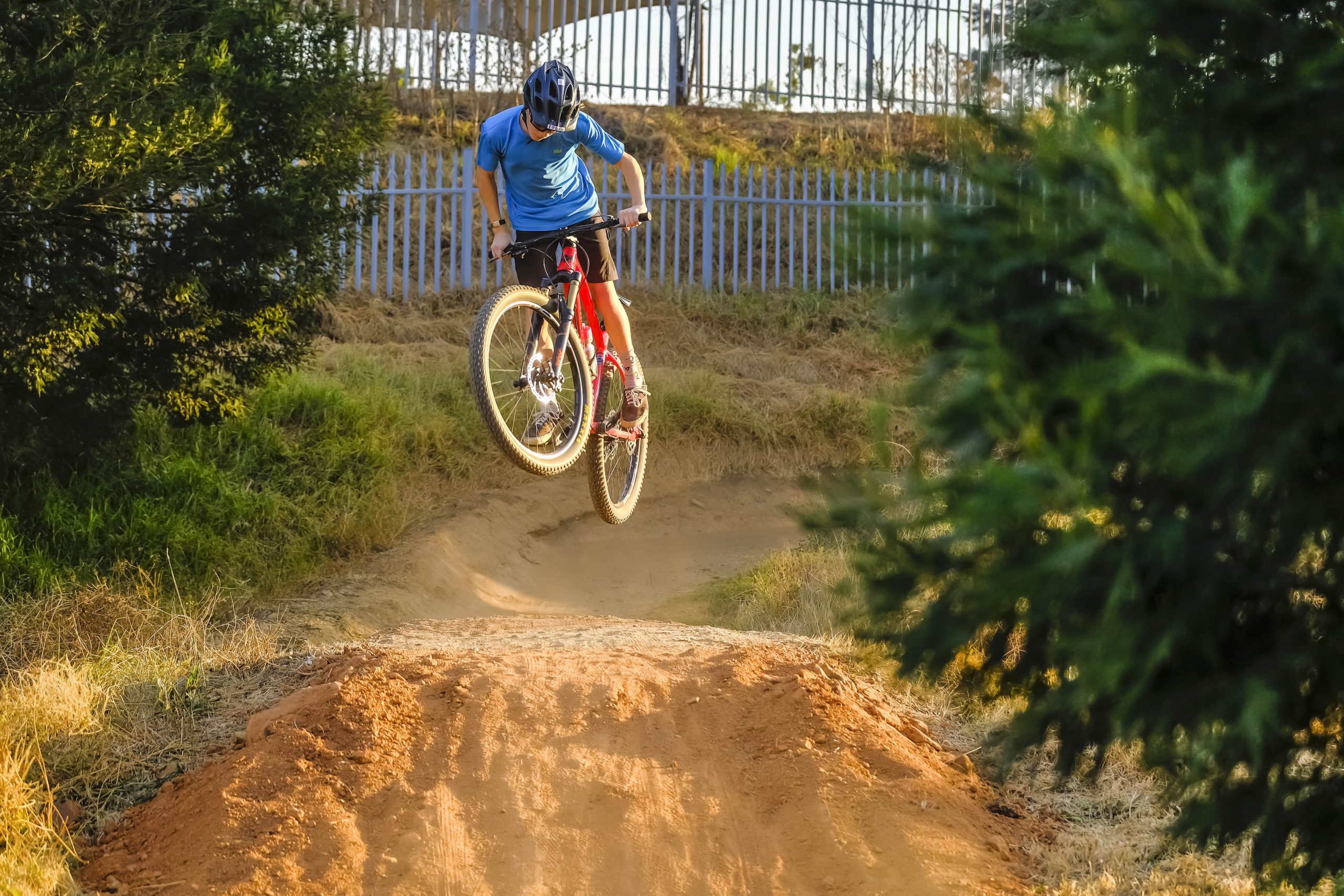There are two kinds of mountain bikers – those that can jump and those that can learn to jump. Jumping a mountain bike is one of the coolest things to do. It feels good and it looks really impressive. It’s something anyone of any age can do. We’ve set about on a multi-level project that’s entirely focussed on learning how to jump. It’s called ‘Mind the Gap’ and it’s pretty much aimed at all mountain bikers. This is Part 1.
By Sean Badenhorst
I used to jump my BMX in the 1980s. Then I got into mountain biking in the 1990s and jumping never really featured much. As I described in this article http://www.treadmtb.co.za/the-mountain-bike-of-south-africas-near-future-looks-like-this/ , mountain biking in South Africa followed a different trajectory to the rest of the world with endurance as its core objective.

Barry Crouse (left) talks me (centre) and Cade through the early phases of learning how to jump properly.
The rest of the world largely pursued fun on mountain bikes and one of the by-products is learning how to do some basic manoeuvres, like bunny hops, drop-offs and jumps. As the young generation of South African mountain bikers pursues fun, jumping comes naturally to them. Mostly. But they still need to develop the right technique and they need to build confidence to consistently jump further or higher. Or both.
My 14-year-old son, Cade, loves riding mountain bikes. For fun. He’s got no interest in riding for three hours because it’s a low-excitement, high-fatigue experience. Sure, he could train to become fit for three hours, but he doesn’t want to. He wants to ride for fun, which includes jumping.
This created a challenge for me. He can’t drive yet and I can’t jump yet. Well, I can jump, but not properly. I leave the ground and I land with stability (mostly), but I only really do this on low-risk jumps. Or should I say jumps with low-risk landings. So, I drive him to jump lines and fumble my way over the jumps while he soars. There’s a very defined generation gap and I’m eager to close it. I know other dads will experience a similar disconnect and this project will hopefully help all of us. This is part of what ‘Mind the Gap’ is about.

Barry and Cade discuss the plan for the jump line at Wolwespruit.
The main objective with our SHRED Mind the Gap project is to emphasise the importance of technique, bike, gear and confidence for young riders that like to ‘send’. If you’re my generation, you need to know that ‘sending’ is jumping in youth speak.
It’s also aimed at presenting the importance to young people of setting a goal and focussing on creating a plan and sticking to it in order to achieve that goal. Instant gratification is cool, but planning, patience, perseverance and pride in a job well done are cooler.
The Goal
For Cade to clear the 10-metre road gap at the end of the Grootfontein Jump Line. For me to learn to jump with confidence on flat pedals.

Cade showing solid technique at the Delta Park jump line on the Morewood Yebo.
The Plan
Source a good jump coach to assist in giving Cade the correct technique and build his confidence. Also needed are a bike and gear that offer the right stability and protection.
The Progress
Our jump coach is Barry Crouse. Barry is an ideal jump coach because he’s 48 years old and only learned to jump properly in the past couple of years via a midlife crisis (a story in itself, which I’ll tell sometime soon). Because I am also a member of this project, I need a jump coach that can relate to me and my poor jumping technique and middle-aged-man fears. Barry is that guy.

Barry demonstrating the heavy-feet position to Cade before tackling the flow line at Wolwespruit.
We started Cade on a Morewood Yebo. A 650b-Plus hardtail trail bike with a Fox 34 fork with 120mm of travel and a Morewood dropper seatpost. A great play-bike with good geometry for jumping.
The first session covered the importance of ‘pumping’ the bike through turns in the flat parking lot and then progressing onto a pump track. Cade is accustomed to flat pedals, but this was my first ride with them. Barry likes to use Wolwespruit venue in Pretoria as the pump track is well made and maintained and the jump line was built and honed by him, Ryan du Rand and Daan Goosen, all perfectionists in the art of getting air…
After spending around 10 minutes in the car park and 20 minutes on the pump track, we moved to the jump line. We were warmed up and just needed to get a feel for the jumps. The jumps at Wolvespruit are designed to be easy on the left and more challenging the further right you take them. This is due to the angle of the take-off slope (steeper is more challenging) and the distance of the tables (longer is more challenging).
We spent around an hour on the jump line and while Cade made good progress, floating smoothly under the guidance of Barry, I was less consistent. Some jumps I felt smoother on and others rather sketchy. Flat pedals are hard to feel confident on when you have spent almost 30 years riding with cleats…

My first flat-pedal ride since I was a teenager on a BMX bike.
It was a start. And overall, a fairly successful start. Both Cade and I learned a lot (me more than him). But I’m 50 and learning something new, especially something risky, is a challenge for sure.
Look out for Mind the Gap Part 2, coming soon.


